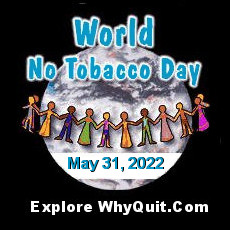World No Tobacco Day - A Call to Action
 The World Health Organization has sponsored World No Tobacco Day every May 31st since 1988. It's a golden opportunity to allow teenagers to go an entire day without being subjected to an invitation to smoke, chew, dip or vape nicotine, a chemical most addiction experts consider more captivating than illegal drugs. Sadly, it won't happen as the industry knows that with nearly five million tobacco related deaths annually, its profits party is over unless it can chemically enslave this next generation of youth.
The World Health Organization has sponsored World No Tobacco Day every May 31st since 1988. It's a golden opportunity to allow teenagers to go an entire day without being subjected to an invitation to smoke, chew, dip or vape nicotine, a chemical most addiction experts consider more captivating than illegal drugs. Sadly, it won't happen as the industry knows that with nearly five million tobacco related deaths annually, its profits party is over unless it can chemically enslave this next generation of youth.
But what if each of us dedicate World No Tobacco Day to removing as much tobacco product use pressure from students as possible. Below are ten youth tobacco use influences and how to diminish or eliminate each:
1. Influence of tobacco industry signs at neighborhood stores
 The neighborhood candy, chip and soda store has increasingly been transformed into nicotine addiction central. Most store owners have little appreciation for the power and cumulative effect of daily bombarding young minds with tobacco marketing, both inside the store and as assaulted while traveling the adjoining sidewalk and road. The average teenager can only absorb so many tobacco use invitations before their collective weight collides with a tobacco use opportunity, resulting in a "what the heck" moment. The dopamine explosion that follows may soon have their brain begging for more.
The neighborhood candy, chip and soda store has increasingly been transformed into nicotine addiction central. Most store owners have little appreciation for the power and cumulative effect of daily bombarding young minds with tobacco marketing, both inside the store and as assaulted while traveling the adjoining sidewalk and road. The average teenager can only absorb so many tobacco use invitations before their collective weight collides with a tobacco use opportunity, resulting in a "what the heck" moment. The dopamine explosion that follows may soon have their brain begging for more.
Industry marketing logos, mantras and pictures create a false adult free-choice facade designed to attack both the conscious and subconscious minds. It endlessly pounds home the message that students are not cool, not rebellious enough, will not have fun friends, experience real pleasure, know true adventure, feel their senses being stirred, or taste earth's best flavors until they have become adult enough to experiment with tobacco. The signs suggest every reason for smoking or using oral tobacco except the truth, that roughly 90% of users do so because they must, because a rising tide of insula driven urges, craves and anxieties will begin arriving if they don't.
Once secret industry documents show that the store's entire tobacco facade -- including "We Card" signs -- is bait to remind youth that smoking is "an anticipatory right of passage," an "initiation into adulthood," a "celebration of maturity." "Insist that smoking is for adults only; make it difficult for minors to obtain cigarettes; continue to have smoking perceived as a legitimate adult activity," writes Philip Morris.
If you are a store owner, for just one day, May 31, either take down all tobacco marketing signs or announce on store doors that the store is a tobacco sales location and that underage youth may not enter. Make a choice: youth customers or marketing nicotine products.
2. The influence of watching tobacco users smoke, dip or chew
Hopefully, we each want to be good adult role models for youth. Studies evidence that youth are substantially more likely to become smokers if parents, adult role models or friends smoke. On May 17, 1988 the U.S. Surgeon General warned that nicotine was as addictive as heroin or cocaine. The Canadian cigarette pack addiction warning reads, "Warning - Cigarettes are highly addictive - Studies have shown that tobacco can be harder to quit than heroin or cocaine."
If the U.S. and Canadian governments are correct, and smoking nicotine truly is in the same league with shooting up heroin, if addicted to heroin would we shoot-up in front of children or teens? Obviously not. Immediately prior to any tobacco use on World No Tobacco Day, stop, look and reflect upon the lesson that would be sent to any young minds in the vicinity.
3. The influence of tobacco use in movies
Studies show that smoking in movies is a significant factor influencing youth smoking initiation. Movie theater owners and operators should screen each movie for tobacco use and warn parents and youth so as to allow for informed viewing decisions. Celebrate World No Tobacco Day by putting a "Tobacco-Free Movie" sticker on each movie poster hanging both inside and outside of the theater.
4. The influence of tobacco use on television
Studies show that the more youth see smoking in television programs the more likely they are to become smokers themselves. Television station owners and operators should have pre-recorded programs and movies screened for World No Tobacco Day. Use scroll bars to provide parents and youth advance notice at the start of each program and following each commercial break as to whether or not the program will subject viewers to smoking or oral tobacco use.
5. Youth peer tobacco use influence
 A 2005 study found that 87% of students smoking at least 1 cigarette per day were already chemically dependent under DSM IV nicotine dependency standards. Contrary to industry boasts that smoking is an "adult" activity, nearly 90% of all new smokers are under 20 years of age. New youth smokers are not imitating adults. They are being fooled into imitating youth led astray, often by friends who themselves were almost always uneducated as to nicotine's ability to quickly and permanently takeover the driver's seat in their minds.
A 2005 study found that 87% of students smoking at least 1 cigarette per day were already chemically dependent under DSM IV nicotine dependency standards. Contrary to industry boasts that smoking is an "adult" activity, nearly 90% of all new smokers are under 20 years of age. New youth smokers are not imitating adults. They are being fooled into imitating youth led astray, often by friends who themselves were almost always uneducated as to nicotine's ability to quickly and permanently takeover the driver's seat in their minds.
Although only 5% of daily smokers surveyed in high school said they would definitely be smoking five years later, about 75% were smoking 7 to 9 years later. Sadly, roughly half of adult smokers already know the cause of death that will be printed on their death certificate.
Friends do not hook friends on smoking nicotine. If you are already experiencing urges and craves to smoke nicotine, or have tried quitting and can't, use World No Tobacco Day as an opportunity to be open and honest with your friends about that next mandatory nicotine feeding.
6. The influence from tobacco ads in magazines
Do you subscribe to Time, Field & Stream, Popular Science or Popular Mechanics? The number and types of magazines still partnering with the industry in helping hook young readers is troublesome. If your family subscribes to any magazines, if your office has waiting-room magazines, or if you run a school or public library, assume responsibility for the influence of tobacco ads within each and remove them. Consider subscribing to responsible magazines that have established policies which reject all tobacco advertising.
7. The influence of newspaper tobacco advertising
Surprisingly, some newspapers still play key roles in community marketing of tobacco. Newspaper owners and publishes should use World No Tobacco Day to ensure your newspaper is not encouraging children or teens to smoke cigarettes or use oral tobacco. Also, look closely for tobacco advertising in weekly grocery store newspaper inserts. How can any newspaper champion protection of youth from tobacco dependency when its own tobacco advertising policy is part of the problem? It creates an obvious financial conflict of interest in allowing serious journalism to fully explore the root causes of the community's leading cause of preventable death.
8. The influence of parents who lack nicotine dependency understanding
Few parents appreciate that "experimentation" with smoking nicotine is statistically the most dangerous act their child can perform. A May 2008 study found that after smoking just one cigarette that 25-30% of youth experienced the tug, pull and beginnings of the loss of the autonomy to simply turn and walk away.
Once enslaved, statistically, among 1,000 20-year-olds who continue to smoke, 6 will die prematurely from homicide, 12 will die in automobile collisions and 500 will die from smoking. Yes, here in the U.S., cigarette smoking contributes to the deaths of roughly half of adult smokers, each an average of 13-14 years early, depending on gender.
Parents who convey the belief to their children that messing with smoking nicotine is not like messing with "real" drugs, may very well be costing them their neuro-chemical freedom, health and life. Use World No Tobacco Day to teach your children the truth, that smoking nicotine is highly addictive and once hooked they will find themselves in the grips of committing slow suicide.
9. The influence of youth educators that lack nicotine dependency understanding
World No Tobacco Day presents teachers, counselors, youth group leaders and religious leaders with an opportunity to teach youth what it means to live life as nicotine's slave. Students need understanding in the critical distinctions between a "nasty little habit" (classical conditioning) and full-blown chemical addiction. What is dopamine's purpose and how does nicotine take dopamine pathways hostage, quickly burying all remaining memory of life without nicotine? What is tolerance and how does nicotine rewire the brain by causing it to grow millions of extra nicotinic-type acetylcholine receptors in at least eleven different brain regions (upregulation)?
What is nicotine? What is nicotine's half-life in human blood serum and why is it the basic clock governing nicotine feedings? How does that next nicotine fix become the new #1 priority in life, more important than eating, learning or spending time with family? Why is nicotine considered "the" gateway drug? How does nicotine damage normal serotonin pathway development in the fetal and adolescent mind? Is it responsible for youth behavioral problems? Does it diminish the rational mind's control over the impulsive mind? Is it really a super toxin that may actually destroy brain gray matter?
10. The influence of elected leaders who lack nicotine dependency understanding
Although local elected leaders have the tools available to protect youth from tobacco marketing, few have given any thought to their use. World No Tobacco Day is a wonderful excuse to explore the use of zoning, tobacco sales ordinances, sales licensing, public nuisance law, and unfair and deceptive trade practices laws, in protecting community youth from indiscriminate scatter-gun tobacco marketing.
Although many nations afford commercial speech constitutional protections, none protect dishonest or deceptive advertising. A substantial portion of store tobacco marketing is subject to direct attack as being false and deceptive. Flavor, taste? How many smokers have taste buds inside their lungs, the place smokers draw and briefly hold cigarette smoke? None. What message is the photograph used in the tobacco advertisement sending? Is the message honest?
It is the primary function of government to protect the health and lives of citizens, especially its young. If not now, when? If not us, who?

